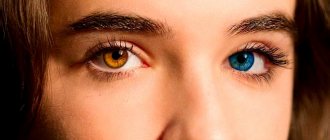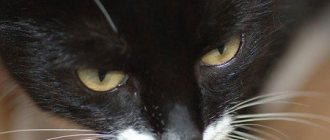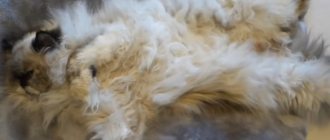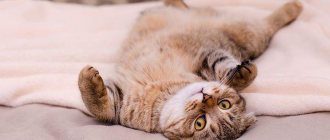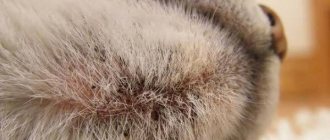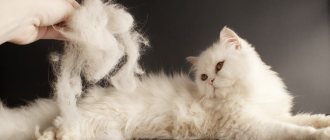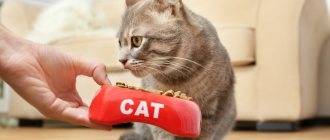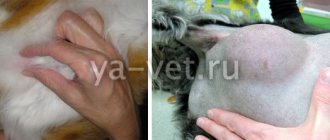Sphynx owners often notice a cluster of black spots on the tail, chin and body of the pet. Pimples that seem innocent at first glance can cause major problems.
To avoid cat health problems, the owner should learn about the characteristics of acne in hairless cats, the causes of acne and the consequences of a frivolous attitude towards the disease.
Why do they appear?
Pimples on sphinxes can have any location. When they appear on the face or neck, the problem mainly lies in improper care of the cat and or poor-quality dishes from which he drinks water and eats. For example, acne often occurs when a cat eats food made from plastic that is rarely washed. In such a situation, veterinarians recommend replacing the bowls with glass ones.
Often, eels appear on the tail of sphinxes during puberty. If acne was noticed at this time, the pet owner should not worry, since it will go away on its own and no specific therapy is required. Treatment will need to be resorted to only in a situation where the rash bothers the cat and he begins to tear it apart. Despite the fact that such pimples do not look very attractive, they do not pose any danger to the cat’s health.
Acne can also be a consequence of genetic predisposition. You can understand whether the sphinx will encounter them by referring to its pedigree. It is possible that pimples will appear on the body of cats due to fungal infection of the skin, disruption of the gastrointestinal tract, or poor nutrition. Sometimes a rash appears as a result of an allergy, which can be to anything.
Diagnostics in a veterinary clinic
To accurately diagnose spots or rashes on the skin, the cat must be taken to a veterinary clinic.
Before visiting a doctor, you need to prepare notes with the dates of the onset of painful signs and the nature of their manifestation, depending on changes in diet or medications. This is important to determine the actual causes of the pet’s illness.
For diagnosis, methods are used that allow us to screen out non-food causes of allergies:
- Skin scraping to determine microbial flora.
- Blood test (if the rash is caused by an insect bite, the test will show this).
- Allergy tests (can determine what you are allergic to: for example, dust, medications, fleas, etc.).
- Prescription of special diagnostic nutrition for a period of up to 2 months to identify food allergens. This type of nutrition introduces completely new products for the animal. During this period, deviations are not allowed, even in the form of a small piece of a familiar delicacy, due to a possible error in diagnosis.
Types and symptoms
Such pets even have comedones.
Acne on the body of the Sphinx is usually divided into 3 types:
- Comedones. During their development, the inflammatory process is weakly expressed. There are comedones, both multiple and single. They are mainly localized on the tail and back. You can find them much less often on the ears and face.
- Nodular cystic acne. These acne are characterized by the appearance of deep infiltrates and cystic cavities, inside of which there is pus. Often this problem is accompanied by skin vasculitis, during which damage to small and medium-sized skin vessels is observed. Pimples are predominantly localized along the spine and on the tail, resembling a shell.
- Rash. Rashes can be caused by an unhealthy diet, allergic reactions, or improper care of your pet. Such acne can affect any area of the body.
If a Sphynx cat's eyes are watery
Brownish and transparent light discharge from a cat's eyes is normal. If white or yellow liquid with a purulent odor flows intensively from the eyes, then an infection should be suspected. The medicine is prescribed by a veterinarian.
Sphynx kittens are born with open eyelids, so from birth there is a high probability of:
- injuries;
- inflammatory processes;
- allergies;
- conjunctivitis;
- corneal ulceration.
Adult Sphynx cats have watery eyes due to allergies or conjunctivitis, which is caused by the lack of eyelashes protecting the eyeballs.
For preventive purposes, the eyes of sphinxes are wiped with tea leaves, chamomile infusion, boiled water or a veterinary remedy.
Diagnostic measures
If a cat develops pimples, it is important for the owner not to self-treat the pet and take it to a veterinarian. The doctor will conduct a visual examination of the cat’s skin, after which he will prescribe the required examinations. During the diagnostic process, it is important to exclude the presence of diseases in the animal that can cause acne:
The animal's condition must be differentiated from demodicosis.
- demodicosis;
- leprosy;
- dermatophytosis;
- fungus;
- tumor of the sebaceous glands.
Susceptibility to this disease
There is no particular pattern regarding which breed of cats is much more likely to suffer from these ailments. However, a number of modern veterinarians are inclined to the point of view that in most cases, black spots on the tail more often occur in sphinxes.
This disease can appear in any cat: breed and age do not play any role in this case.
There is a very low chance of acne appearing on the tail of a neutered cat. But we cannot say with certainty that castration can save your beloved pet from the appearance of black dots on its tail. Hereditary factors also influence the formation of acne.
How to remove acne?
General recommendations
If your Sphynx has black spots on its skin, doctors recommend changing your pet's diet. You should not give cats sweets, excessively salty foods, or fatty foods. You need to add boiled lean meat to your diet. Turkey, rabbit, veal and chicken fillet are suitable. Eggs, vegetables, buckwheat and rice cereals will be beneficial for cats. Once a week, animals are allowed to be given boiled fish and fermented milk products. If the owner prefers to feed the cat with industrial complementary foods, veterinarians recommend choosing high-quality representatives from the premium segment.
When cats have a rough tail due to the appearance of a so-called acne shell on it, which may be caused by a fungal infection, antibacterial medications are prescribed. Amoxicillin is often used. In addition, an ointment called “Zinerit” is prescribed, which helps to quickly remove acne on the body of the sphinx. If the problem is related to allergic reactions, it is important to identify the allergen and avoid contact with it. Sometimes corticosteroids may be prescribed. However, it is important for the animal owner to remember that these medications provoke a lot of side effects, so their use is only permissible in advanced situations.
If therapy does not help, veterinarians advise castration of your pet, since surges in hormones often cause the formation of rashes.
Skin care
Specific plaque on the animal’s body must be removed with wet wipes.
Skincare procedures in combination with drug therapy and diet will help quickly remove acne on the Sphynx’s body. The cat owner needs to remember that all cats of this breed are covered with a wax-like coating that protects the skin from environmental influences. This plaque will need to be systematically removed with wet wipes that do not contain alcohol or a moistened terry towel.
The skin of some Sphynx cats often peels, which can also cause acne. To avoid this problem, the air in the house and your pet's skin will need to be moisturized. It is permissible to use animal body oil or shampoo that has moisturizing properties. It is important that bathing products must be suitable for this breed of cat.
If we talk about swimming, then the opinion on this matter is ambiguous. On the one hand, it is necessary to remove plaque from the skin, and on the other hand, abuse of water procedures provokes its increased secretion. Sphynx cats need to be bathed, but should not be overused. Veterinarians from the Zoovet clinic recommend adding decoctions of medicinal herbs to the water. Chamomile, string, calendula are suitable. It is also permissible to do steam baths. It must be remembered that squeezing out pimples on your own, even after steaming, is strictly prohibited, since the possibility of infection cannot be ruled out.
Causes of acne in cats
Acne usually appears when the sebaceous glands malfunction. The process is based on the exfoliation of dead cells and secretions secreted by gland cells. For this reason, the ducts become clogged, due to peeling and secretion, the skin microflora deteriorates and stops multiplying, and as a result, irritation occurs. Experts have not yet fully figured out why this happens.
There can be quite a lot of factors for the appearance of “black dots”. The reasons are exogenous (external) and endogenous (internal). If this happens, you should think about and reconsider caring for your pet.
Endogenous factors of acne are considered:
- hormonal disbalance;
- metabolic disease;
- allergies to objects, food;
- liver problems;
- individual skin characteristics;
- the appearance of parasites in the body.
Exogenous factors are considered:
- dirty food bowls - the animal gets its face dirty, and food debris blocks the sebaceous ducts;
- When sick or old, cats begin to wash themselves poorly or stop taking care of themselves altogether;
- wounds and scratches can cause irritability;
- overvoltage;
- poor nutrition.
The main factors include:
- Incorrect feeding. The pet must receive all the necessary food for the normal functioning of the body. Malnutrition and overfeeding should be avoided.
- Infection. If an animal has bacterial or fungal infections, this can have a bad effect on the body, including the skin.
- Paraanal glands. This is also considered an important factor, since they directly affect the normal functioning of the skin. And even if your pet’s anal glands are fine, it’s still better to play it safe and have them checked.
- Bowl for food. First of all, you need to pay attention to what kind of dishes your cat eats from, what material the bowls are made of, and what sanitary condition they are in.
Important! Spayed and neutered cats are least susceptible to this disease. This is due to changes in the pet’s hormonal levels after surgery, which is not prone to rapid changes in sexual activity.
How to treat alopecia in children?
The treatment method depends on the cause of alopecia in children, which is determined during the examination. In addition to general therapy, doctors often prescribe additional hair care products (external) and multivitamin complexes. Source: N.V. Pats Treatment of alopecia in children (literature review) // Journal of GrSMU, 2006, No. 3, pp. 8-11
If the baldness is not caused by a serious medical condition that needs to be addressed immediately, a “cure by waiting” may be recommended. In this case, the child is monitored for several months. During this time, the pathology may go away on its own.
Treatment with traditional methods is prohibited. This can aggravate the underlying cause and affect the child's future life.
Therapy should be based on the identified cause of hair loss. In all cases, children are prescribed restorative treatment, which includes:
- immunomodulators;
- phytina;
- vitamins A, E, C, B1, B6, B12;
- methionine;
- pantothenic acid;
- for total alopecia - systemic administration of hormonal drugs.
In the case of the topical type of the disease, ultraviolet irradiation of the foci of hair loss is performed. They are first lubricated with a photosensitizing drug based on amia major, parsnip, and methoxsalene. Darsonvalization of the scalp is also performed.
Every day, the scalp is cooled with chlorethyl, various tinctures and emulsions, and prednisolone-based ointment should be rubbed into it.
If a child has lost hair due to a burn, then new hair will not grow at the site of the scar if conservative therapy is used. Only a skin transplant can help.
Alopecia is psychologically difficult for a child, so he may need the help of a child psychologist.
Sources:
- E.V. Maslova, O.N. Pozdnyakova. Structure and clinical variants of alopecia in the practice of a dermatovenerologist // Journal of Siberian Medical Sciences, 2012, No. 2.
- N. Bekbauova, R. Aliyeva, Zh. Zharasova, O. Stepanova. Etiology of alopecia areata in children // Medical Journal of Western Kazakhstan, 2012, No. 3(35), p.90.
- N.V. Pats. Treatment of alopecia in children (literature review) // Journal of GrSMU, 2006, No. 3, pp. 8-11.
The information in this article is provided for reference purposes and does not replace advice from a qualified professional. Don't self-medicate! At the first signs of illness, you should consult a doctor.
Treatment method and prognosis
If instrumental and laboratory tests do not confirm a food allergy, then the doctor’s prescription usually contains:
- antimicrobial treatment (to alleviate the pet’s condition);
- antihistamines;
- compliance with special diagnostic nutrition.
If a food allergen is identified, it is necessary to reconsider the Sphynx's diet.
Treatment of food allergies is a lengthy process that requires no relief. Compliance with the cat's nutritional requirements will need to be observed throughout the animal's life, avoiding allergens from entering the food.
What to do at home
According to the treatment and nutrition regimen prescribed by the doctor, it is necessary to begin restoring the pet’s health.
Noting the sensitivity of sphinxes to various drugs, as well as food compounds of proteins and carbohydrates, you need to carefully monitor your pet’s skin. If spots (rashes, ulcers, etc.) increase, you should immediately contact the clinic to adjust the course.
When taking medications, you should pay attention to the dosage depending on the weight and age of the animal. Overdose is unacceptable.
Diagnostic nutrition should be given only in the combination indicated by the doctor. Deviations from the diagnostic diet are unacceptable.
To eliminate the sphinx’s nervousness due to the lack of treats and the need to take medications, you should pay more attention to the animal, as well as regularly change drinking water and provide it with a warm sleeping place.

